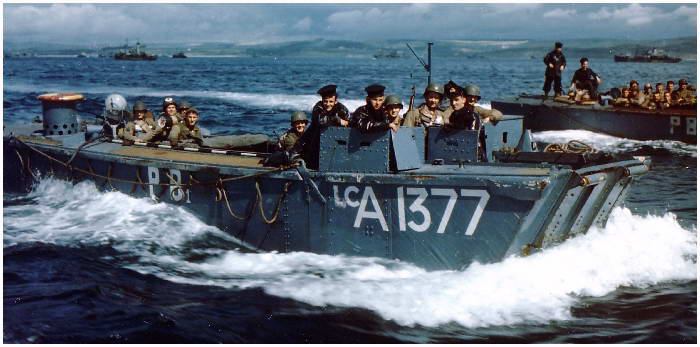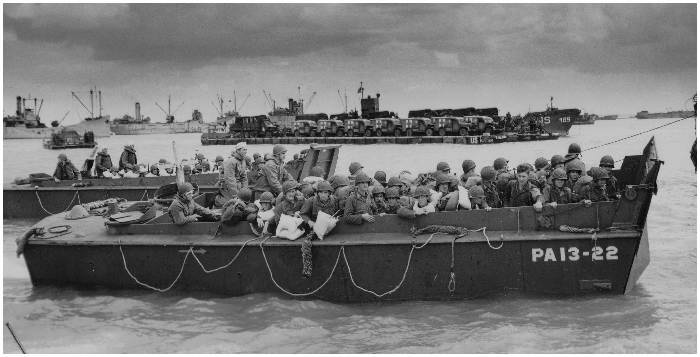The LCA, LCVP & LCM

LCA's with American
GI's and British crews during an exercise.
Landing Craft Assault
(LCA)
The British Landing Craft Assault (LCA) was the assault
boat together with the American LCVP, that were deployed as
the first wave with men to go ashore in Normandy on 6th June,
1944. The LCA was a rectangle wooden construction armoured
with extra steel plating. Because of the extra weight it run
deeper than the American LCVP. The LCA was launched from the
davits of bigger ships, like the LST or troop transport ships.
The 12.50 meter long vessel could hold 36 men. During D-Day
418 LCA’s were used and 184 were lost that day.

New constructed LCA's from the 1500 series during handover
An LCA had 35 men and 400 kilo’s cargo on board and four crewmen. The length of the LCA was
14 meters with an empty space of 6 by 3 meters for the troops. The weapons for self-defence were
a Bren machinegun on the portside (left) and two .303 Lewis machineguns. The propulsion was from
a 65hp Ford V-8 engine which gave the LCA around 6 knots of speed.

The rear of an LCA
A striking LCA version was used during the assault on Point
du Hoc, Normandy. They were Equipped with six launch tubes to propel four-toothed
hooks up the cliffs.

A model of an LCA
that was used at Point du Hoc (Ranger Museum,
Grandcamp)
The LCA’s saw action during the landing at Dieppe (Operation Jubilee), the invasion
in Normandië (Operation Overlord), the landings in the south of France (Operation
Dragoon) and the fighting for the Scheldt estuary in November 1944 (Operation Infatuate).
They were not used just for these large scale strikes alone, LCA’s were also deployed for smaller actions,
like commando strikes.

LCA 106 during Operation Archery, the commando raid
at Vaagso on December 27, 1941
Landing Craft,
Vehicle and Personnel (LCVP)

The development of the LCVP started in the thirty’s. Andrew
Higgins, owner of Higgins Industries, Inc, New Orleans, designed the
‘Eureka’. This vessel had a remarkable shallow depth. It was
extremely usable in the swamps of Louisiana. Higgins was a
visionary, and knew a war was imminent, and that thousands of
boats would be needed. Steel would be in short supply, so he
bought the whole year supply of mahogany in 1939 from the
Philippines. The so called ‘long leaf yellow pine’ from
Louisiana was also used in the boats that Higgins built. When
the Marines requested the American Navy to experiment with
landing craft, Higgins’ designs were also reviewed. Because
the NBS, Navy Bureau of Ships, wanted to have total control
over the project, the plans Higgins brought in were swept from
the table. This was mainly due to the man himself, he was some
of a character, his Irish blood was short-tempered and they
didn’t want their boats made out of wood.

An LCVP loaded with men during a training
But after some pressure
in the years that followed, he got the permission to built his
LCVP (Landing Craft, Vehicle and Personnel) and enter the
competition. The Marines liked it straight away, this was the
boat they wanted.
These landing craft were superior to anything what was
available at that moment. The LCVP, with its length of 11.50
meters, had a weight of 7000 kg and was not more than an open
box with a bow-ramp. There was room for 36 men or a jeep with
12 men.

After debarkation, the LCVP could turn fast around and
go for another cargo of men. The 6 cylinder Gray diesel engine
gave the LCVP a speed of 12 knots. There were boats with a
Hall Scott petrol engine. These had more power, but were also
more vulnerable to fire.

A well known picture taken of an LCVP at Omaha Beach
Was this landing craft official known
as an LCVP, to the crew and soldiers it was called the
‘Higgins Boat’. To stimulate his more than 20.000 working
force, there was an enormous sign under the ceiling of the
factory with the text: ‘The Guy Who Relaxes Is Helping The
Axis’. A total of 23.358 LCVP’s were produced. The price for
one LCVP was at the time $ 12.000. On D-Day there were 839 at
hand, 57 were lost that day.
 
Eisenhower declared to writer Stephen Ambrose about
Andrew Higgins:
‘He is the man who won the war for
us.’
Nowadays there are just a couple of these LCVP’s around.
There are four to locate in Normandy. One recent restored is
displayed at the Musée ‘Omaha 6 Juin 1944’ in St.Laurent. Two
others can be found near the museum ‘Exposition OMAHA’ at
Vierville-sur-Mer. Furter, at the Utah Beach is a good
preserved LCVP on display.

The LCVP at the museum in Vierville-sur-Mer
Not only the LCVP was built by Higgins, but also the LCM,
Landing Craft, Mechanised.

From left to right,
an LCI, an LCM and two LCVP's, on the horizon an
LST
Landing Craft
Mechanised (LCM)

A LCM is to be found in Ouistreham, at La Grand Bunker,
it was once used in the movie 'Saving Private Ryan'
At first site, the Landing Craft, Mechanised (LCM) looks
like the LCVP. Distinctive feature on this type was the high
bow-ramp. Further more, with its length of 15.20 meter it was
much larger then the LCVP. Another difference was the used
material, the LCM was almost completely built out of steel plate
(with exception with the early ones, which had wooden coxswains shelters for the
compasses, so they would not be affected by the steel).

This LCM brings back exhausted and wounded
GI's from Omaha Beach
Because of the strength of this boat it could transport a
middleweight tank, like the M4 Sherman Tank .
Development started in early May 1941. Within 61 hours, Andrew Higgins,
designed, built the first LCM, which was then tested before high ranking officials of
the Marine Corps and Navy on May 30, 1941.

The Higgins factory,
LCVP's in production, notice the sign on the
ceiling!
The LCM was already known to the British,
who had built and used the Mk 1 and the Mk 2. The LCM from Higgins became the LCM Mk 3, also called the 'tanker lighter'.
Higgins built also an extended version of the LCM, the LCM 6.
This could carry an M4 Sherman tank with ease, or 60 packed soldiers
When the production ended, some 11.392 LCM’s
were built. At D-Day there were 486 at hand, 78 were lost
during the next two days.

LCM's (just as LCVP's)
were used to cross rivers as well
For the amphibious vehicles,
the DUKW and the LVT,
CLICK HERE
|